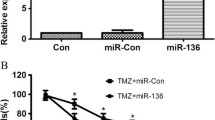Abstract
Purpose
Aplysin, a natural brominate compound from marine organisms, has been demonstrated to exhibit anti-tumor activity, mainly by inducing apoptosis and cell cycle arrest. However, its effect on glioma is still unknown. In this study, we evaluated the effects of aplysin on the malignant properties of glioma cells and its enhancing effect on temozolomide (TMZ) action against drug-resistant glioma cell lines.
Methods
We employed several human glioma cell lines and primary glioma cells to address this issue with multidisciplinary approaches.
Results
The combined application of aplysin and TMZ significantly sensitizes glioma cells to TMZ action, compared with TMZ alone. miRNA profile analysis revealed that the abundance of miR-181, an important glioma tumor suppressors believed to enhance TMZ effect, was greatly elevated in aplysin-treated glioma cell lines. The aplysin-induced TMZ sensitivity is dependent on MEK1 in glioma cells. Overexpression of MEK1 was able to abolish the effect of aplysin on glioma cells.
Conclusions
We found that aplysin can enhance the effect of TMZ on glioma cells by increasing miR-181 expression.






Similar content being viewed by others
Change history
26 October 2020
A Correction to this paper has been published: https://doi.org/10.1007/s00280-020-04166-1
References
Reardon DA, Galanis E, DeGroot JF, Cloughesy TF, Wefel JS, Lamborn KR, Lassman AB, Gilbert MR, Sampson JH, Wick W, Chamberlain MC, Macdonald DR, Mehta MP, Vogelbaum MA, Chang SM, Van den Bent MJ, Wen PY (2011) Clinical trial end points for high-grade glioma: the evolving landscape. Neuro Oncol 13(3):353–361. doi:10.1093/neuonc/noq203
Chang L, Su J, Jia X, Ren H (2014) Treating malignant glioma in Chinese patients: update on temozolomide. Onco Targets Ther 7:235–244. doi:10.2147/OTT.S41336
Johannessen TC, Bjerkvig R (2012) Molecular mechanisms of temozolomide resistance in glioblastoma multiforme. Expert Rev Anticancer Ther 12(5):635–642. doi:10.1586/era.12.37
Wang J, Sai K, Chen FR, Chen ZP (2013) miR-181b modulates glioma cell sensitivity to temozolomide by targeting MEK1. Cancer Chemother Pharmacol 72(1):147–158. doi:10.1007/s00280-013-2180-3
Ge N, Liang H, Liu Y, Ma AG, Han L (2013) Protective effect of Aplysin on hepatic injury in ethanol-treated rats. Food Chemical Toxicol 62:361–372. doi:10.1016/j.fct.2013.08.071
Liang H, Liu Y, Ge N, Ma AG (2013) Effects of aplysin on the apoptosis of human breast can FCM-7 cell. Ann Nutr Metab 63:1660
Tian X, Tang H, Lin H, Cheng G, Wang S, Zhang X (2013) Saponins: the potential chemotherapeutic agents in pursuing new anti-glioblastoma drugs. Min Rev Med Chem 13(12):1709–1724
Shi L, Cheng Z, Zhang J, Li R, Zhao P, Fu Z, You Y (2008) hsa-mir-181a and hsa-mir-181b function as tumor suppressors in human glioma cells. Brain Res 1236:185–193. doi:10.1016/j.brainres.2008.07.085
Chen G, Zhu W, Shi D, Lv L, Zhang C, Liu P, Hu W (2010) MicroRNA-181a sensitizes human malignant glioma U87MG cells to radiation by targeting Bcl-2. Oncol Rep 23(4):997–1003
Kouri FM, Jensen SA, Stegh AH (2012) The role of Bcl-2 family proteins in therapy responses of malignant astrocytic gliomas: Bcl2L12 and beyond. ScientificWorldJournal 2012:838916. doi:10.1100/2012/838916
Hummel TR, Chow LM, Fouladi M, Franz D (2013) Pharmacotherapeutic management of pediatric gliomas : current and upcoming strategies. Paediatr Drugs 15(1):29–42. doi:10.1007/s40272-012-0002-4
Nakada M, Furuta T, Hayashi Y, Minamoto T, Hamada J (2012) The strategy for enhancing temozolomide against malignant glioma. Front Oncol 2:98. doi:10.3389/fonc.2012.00098
Holt SV, Logie A, Odedra R, Heier A, Heaton SP, Alferez D, Davies BR, Wilkinson RW, Smith PD (2012) The MEK1/2 inhibitor, selumetinib (AZD6244; ARRY-142886), enhances anti-tumour efficacy when combined with conventional chemotherapeutic agents in human tumour xenograft models. Br J Cancer 106(5):858–866. doi:10.1038/bjc.2012.8
Conflict of interest
None.
Author information
Authors and Affiliations
Corresponding author
About this article
Cite this article
Gong, A., Ge, N., Yao, W. et al. RETRACTED ARTICLE: Aplysin enhances temozolomide sensitivity in glioma cells by increasing miR-181 level. Cancer Chemother Pharmacol 74, 531–538 (2014). https://doi.org/10.1007/s00280-014-2534-5
Received:
Accepted:
Published:
Issue Date:
DOI: https://doi.org/10.1007/s00280-014-2534-5




